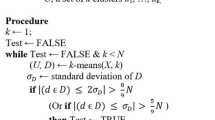Abstract
In this paper, we propose an unsupervised point clustering framework. The goal is to cluster N given points into K clusters, so that similarities between objects in the same group are high while the similarities between objects in different groups are low. The point similarity is defined by a voting measure that takes into account the point distances. Using the voting formulation, the problem of clustering is reduced to the maximization of the sum of votes between the points of the same cluster. We have shown that the resulting clustering based on voting maximization has advantages concerning the cluster’s compactness, working well for clusters of different densities and/or sizes. In addition, the proposed scheme is able to detect outliers. Experimental results and comparisons to existing methods on real and synthetic datasets demonstrate the high performance and robustness of the proposed scheme.
Similar content being viewed by others
References
ARTHUR, D., and VASSILVITSKII, S. (2007), “K-Means++: The Advantages of Careful Seeding”, in Proceedings of the Eighteenth Annual ACM-SIAM Symposium on Discrete Algorithms, pp. 1027–1035.
BLAKE, C., KEOUGH, E., and MERZ, C.J. (1998), “UCI Repository of Machine Learning Database”, http://archive.ics.uci.edu/ml/.
BRUCKER, P. (1978), “On the Complexity of Clustering Problems”, Optimization and Operations Research 157, 45–54.
CHEN, W.-Y., SONG, Y., BAI, H., LIN, C.J., and CHANG, E.Y. (2011), “Parallel Spectral Clustering in Distributed Systems”, IEEE Transactions on Pattern Analysis and Machine Intelligence 33(3), 568–586.
CHOU, C., SU, M., and LAI, E. (2004), “A New Cluster Validity Measure and Its Application to Image Compression”, Pattern Analysis and Applications 7(2), 205–220.
DAS, S., ABRAHAM, A., and KONAR, A. (2008), “Automatic Clustering Using an Improved Differential Evolution Algorithm”, IEEE Transactions on Systems, Man and Cybernetics, Part A: Systems and Humans 38(1), 218–237.
DAY, W., and EDELSBRUNNER, H. (1984), “Efficient Algorithms for Agglomerative Hierarchical Clustering Methods”, Journal of Classification 1(1), 7–24.
DEMˇSAR, J. (2006), “Statistical Comparisons of Classifiers Over Multiple Data Sets”, The Journal of Machine Learning Research 7, 1–30.
DRINEAS, P., FRIEZE, A., KANNAN, R., VEMPALA, S., and VINAY, V. (2004), “Clustering Large Graphs via the Singular Value Decomposition”, Machine Learning 56(1), 9–33.
FREY, B., and DUECK, D. (2007), “Clustering by Passing Messages Between Data Points”, Science 315(5814), 972–976.
FRIGUI, H., and KRISHNAPURAM, R. (1999), “A Robust Competitive Clustering Algorithm with Applications in Computer Vision”, IEEE Transactions on Pattern Analysis and Machine Intelligence 21(5), 450–465.
GUPTA, U., and RANGANATHAN, N. (2010), “A Game Theoretic Approach for Simultaneous Compaction and Equipartitioning of Spatial Data Sets”, IEEE Transactions on Knowledge and Data Engineering 22(4), 465–478.
HRUSCHKA, E., CAMPELLO, R., FREITAS, A., and DE CARVALHO, A. (2009), “A Survey of Evolutionary Algorithms for Clustering”, IEEE Transactions on Systems, Man, and Cybernetics, Part C: Applications and Reviews 39(2), 133–155.
HUBERT, L., and ARABIE, P. (1985), “Comparing Partitions”, Journal of Classification 2(1), 193–218.
JAIN, A., MURTY, M., and FLYNN, P. (1999), “Data Clustering: A Review”, ACM Computing Surveys (CSUR) 31(3), 264–323.
JAIN, A. (2010), “Data Clustering: 50 Years Beyond K-Means”, Pattern Recognition Letters 31(8), 651–666.
KATSAVOUNIDIS, I., KUO, C.-C.J., ZHANG, Z. (1994), “A New Initialization Technique for Generalized Lloyd Iteration”, IEEE Signal Processing Letters 1(10), 144–146.
KUHN, H. (1955), “The Hungarian Method for the Assignment Problem”, Naval Research Logistics Quarterly 2(1-2), 83–97.
LASZLO, M., and MUKHERJEE, S. (2005), “Minimum Spanning Tree Partitioning Algorithm for Microaggregation”, IEEE Transactions on Knowledge and Data Engineering 17(7), 902–911.
MACQUEEN, J.B. (1967), “Some Methods for Classification and Analysis of Multivariate Observations”, in Proceedings of the Fifth Berkeley Symposium on Mathematical Statistics and Probability, Vol. 1, pp. 281–297.
NEWMAN, M., and GIRVAN, M. (2004), “Finding and Evaluating Community Structure in Networks”, Physical Review E 69(2), 026–113.
PANAGIOTAKIS, C., PELEKIS, N., and KOPANAKIS, I. (2009), “Trajectory Voting and Classification Based on Spatiotemporal Similarity in Moving Object Databases”, in Proceedings of the 8th International Symposium on Intelligent Data Analysis, pp. 131–142.
PANAGIOTAKIS, C., PELEKIS, N., KOPANAKIS, I., RAMASSO, E., and THEODORIDIS, Y. (2012), “Segmentation and Sampling of Moving Object Trajectories Based on Representativeness”, IEEE Transactions on Knowledge and Data Engineering 24(7), 1328–1343.
PANAGIOTAKIS, C., and TZIRITAS, G. (2013), “Successive Group Selection for Microaggregation”, IEEE Transactions on Knowledge and Data Engineering 25(5), 1191–1195.
PELLEG, D., and MOORE, A. (2000), “X-means: Extending K-means with Efficient Estimation of the Number of Clusters”, in Proceedings of the Seventeenth International Conference on Machine Learning, San Francisco: Morgan Kaufmann, pp.727–734.
PELEKIS, N., KOPANAKIS, I., PANAGIOTAKIS, C., and THEODORIDIS, Y. (2010), “Unsupervised Trajectory Sampling”, in Machine Learning and Knowledge Discovery in Databases, Springer, pp. 17–33.
THEODORIDIS, S., and KOUTROUMBAS, K. (2006), Pattern Recognition (3rd ed.), Elsevier. VON LUXBURG, U. (2007), “A Tutorial on Spectral Clustering”, Statistics and Computing 17(4), 395–416.
Author information
Authors and Affiliations
Corresponding author
Additional information
This research has been partially co-financed by the European Union (European Social Fund - ESF) and Greek national funds through the Operational Program “Education and Lifelong Learning” of the National Strategic Reference Framework (NSRF) - Research Funding Projects: THALISUOA-ERASITECHNIS MIS 375435, ARCHIMEDE III-TEI-Crete-P2PCOORD and THALIS-NTUA-UrbanMonitor.
Rights and permissions
About this article
Cite this article
Panagiotakis, C. Point Clustering via Voting Maximization. J Classif 32, 212–240 (2015). https://doi.org/10.1007/s00357-015-9182-2
Published:
Issue Date:
DOI: https://doi.org/10.1007/s00357-015-9182-2




